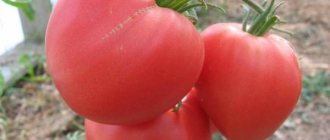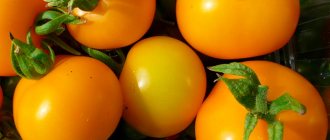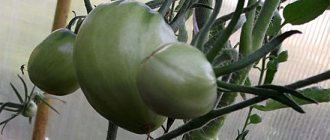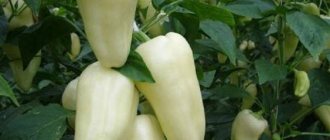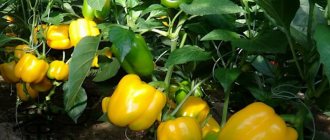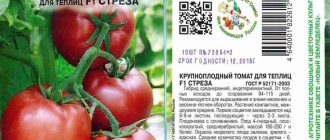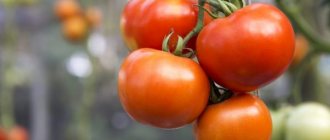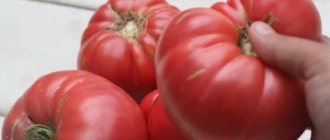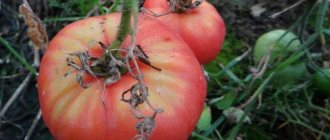Description of the variety
The characteristics and description of the Sensei tomato variety are as follows:
- early ripening variety;
- high productivity;
- determinate standard bush;
- the height in the greenhouse reaches 1.5 m;
- moderate amount of green mass;
- 3-5 tomatoes ripen on one bunch;
The fruits of the Sensei variety have a number of features:
- big sizes;
- weight up to 400 g;
- rounded heart-shaped;
- pronounced ribbing at the stalk;
- crimson-red color of tomatoes.
Diseases and pests
The tomato variety “Sensei” has excellent immunity to characteristic tomato diseases. It is not afraid of late blight, Fusarium or Verticillium wilt, Alternaria, and tobacco mosaic. Nevertheless, it is recommended to carry out preventive measures to prevent the occurrence of diseases:
- Regular ventilation of greenhouse structures;
- Timely weeding of beds;
- Preventive spraying of plantings with antifungal bio-preparations.
No less dangerous to tomatoes are pests that cause significant damage to plants. The most common are Colorado potato beetles, aphids, thrips, and spider mites. For timely detection of pests, it is necessary to periodically inspect the plantings, looking under the leaves. To destroy flying insects, the use of potent insecticidal preparations is effective, after 2-3 treatments. Slugs are collected manually, and then the bushes are sprayed with an aqueous solution of ammonia.
Boarding order
Sensei tomatoes are grown using the seedling method. First, the seeds are planted at home. Grown plants are planted in open areas or in a greenhouse. The soil is prepared for planting and fertilized with compost or minerals.
Growing seedlings
The soil for Sensei tomato seedlings is prepared in the fall. It is obtained by combining equal amounts of humus and turf soil. Soil permeability can be improved by adding peat or sand. In garden stores you can purchase ready-made soil mixtures for tomato seedlings.
If garden soil is used, it must be disinfected by placing it in a heated microwave or oven. This treatment takes no more than 10-15 minutes.
Advice! Healthy seedlings are obtained by using coconut substrate or peat tablets.
Then they move on to preparing the seed material. To improve germination, seeds are wrapped in a damp cloth for a day. The material is also treated with a solution of Fitosporin or salt. Purchased seeds do not require processing, as evidenced by their bright color.
For tomato seedlings, prepare containers 10 cm high, which are filled with soil. For planting, depressions of 1 cm are made, where seeds are placed every 2 cm. The seed material is sprinkled with earth on top, after which the plantings are watered.
Tomato seedlings appear most quickly at a temperature of 25-30 degrees. A few days later, when the first shoots appear, the containers are transferred to the window. Within 12 hours, the seedlings should be well lit. If necessary, additional lighting is installed.
When the soil dries out, it is necessary to water the tomatoes. It is best to use warm, settled water, which is applied using a spray bottle.
Planting in a greenhouse
You can transfer Sensei tomatoes to the greenhouse after they reach a height of 20 cm. 2 months after planting, the plants form a strong root system and 4-5 leaves.
The greenhouse is prepared for tomatoes in the fall. It is recommended to remove about 10 cm of soil cover as it becomes an overwintering site for insect larvae and fungal spores. The remaining soil is dug up and humus is added to it.
As fertilizer per 1 sq. m it is recommended to add 6 tbsp. l. superphosphate, 1 tbsp. l. potassium sulphide and 2 cups of wood ash.
Important! Tomatoes are not grown in one place for two years in a row. At least 3 years must pass between crop plantings.
Sensei tomatoes are grown in a greenhouse made of polycarbonate, glass or film. Its frame is made of aluminum, which is a durable and lightweight material. The greenhouse is not installed in shady areas, since tomatoes require good lighting during the day.
Seedlings of the Sensei variety are placed in increments of 20 cm. A gap of 50 cm is made between the rows. The tomatoes are placed together with a lump of earth in the prepared holes, after which they are covered with soil and moisture is added.
Growing in open ground
According to reviews, the Sensei tomato variety is successfully grown in open areas, if climatic conditions permit. To do this, use seedlings or plant seeds directly in the beds.
Work is carried out when the soil and air have warmed up well and spring frosts have passed. For some time after planting the tomatoes, they are covered with agrofibre at night.
Beds for tomatoes are equipped in the autumn. The soil must be dug up, humus and wood ash added. Areas where cucumbers, cabbage, onions, beets, herbs, legumes and melons previously grew are suitable for tomatoes. Do not use beds after tomatoes, eggplants, potatoes and peppers.
Advice! The area should be well lit and protected from the wind.
In open ground, holes for tomatoes are placed at a distance of 40 cm. Intervals of 50 cm are made between the rows. After transferring the plants, their root system must be covered with soil, the soil compacted and watered well.
Growing tomatoes
To cultivate the Sensei variety, the seedling method is used.
How to prepare seeds?
Description:
- Purchased seed material is not disinfected, since the necessary treatment was carried out immediately before sale. Self-collected seeds need disinfection with salt or “Fitosporin”;
- Next, the planting material is soaked in a growth stimulator for 10-12 hours, no more. Aloe juice can be an analogue of a growth stimulator.
Sowing seed material
Description:
- Sowing seeds for seedlings begins in the first or second ten days of March;
- Sifted river sand is added to turf or garden soil. To increase nutritional value, add a small portion of superphosphate, potassium fertilizers or wood ash to the soil mixture;
- After the formation of two full-fledged leaves, the seedlings are planted in separate containers;
- After picking, the seedlings must be fed with a liquid fertilizer complex.
Rules for planting seedlings
Description:
- You can begin replanting to a permanent place of growth as soon as the soil has completely warmed up and night frosts have passed. By the time of planting, seedlings should have 6-7 true leaves;
- The soil is first loosened and dug up;
- Any complex fertilizer, for example superphosphate, is added to each planting hole;
- The distance between tomato bushes is maintained at 20 cm, the width between rows is at least 60 cm;
- Planted seedlings must be watered.
Tomato care
Caring for the Sensei variety includes watering and fertilizing. The formation of a bush helps control the growth of green mass. Tomatoes are little susceptible to diseases in an optimal microclimate.
Watering the plantings
Tomato Sensei needs moderate watering, which is done in the morning or evening. First, the water must settle and warm up in barrels. Do not water tomatoes with a hose, since exposure to cold water is stressful for the plants.
Important! Watering is carried out only at the roots of plants.
For each tomato bush you need to add 3 to 5 liters of water. The first watering is carried out a week after planting the tomatoes in a permanent place. Before flowering begins, they are watered every 3-4 days with 3 liters of water. When forming inflorescences and ovaries, plants require 5 liters of water, but it is enough to carry out the procedure weekly. The amount of water when watering should be reduced during fruit formation.
Fertilizer application
According to reviews, Sensei tomatoes produce a stable harvest when using fertilizers. During the season, fertilizers are applied several times as root and leaf feeding. During root treatment, a solution is prepared which is used to water the plantings. Foliar feeding involves spraying tomatoes.
The first application of fertilizing is made after 10 days of planting tomatoes in the prepared area. Add superphosphate and potassium sulfate (35 g each) to 10 liters of water, after which the plants are watered at the root. Phosphorus strengthens the root system of plants, and potassium improves the taste of fruits.
When flowering, tomatoes are treated with a solution of boric acid (10 g of fertilizer is required for a 10-liter bucket of water). By spraying, you can prevent the inflorescences from falling off and stimulate the formation of ovaries.
From folk remedies, tomatoes are fed with wood ash, which is applied directly to the soil or an infusion is obtained from it. Ash is rich in calcium, potassium, magnesium and other trace elements that are easily absorbed by tomatoes.
Tying and pinching
According to its characteristics and description, the Sensei tomato variety is tall and therefore requires staking. A support in the form of a metal or wooden plank is installed for each bush. Plants are tied at the top. When fruits appear, the branches also need to be secured to a support.
The Sensei variety is formed into one or two stems. Side shoots growing from the leaf axil must be removed manually. By pinching, you can control the density of plantings and direct the strength of tomatoes to fruiting.
Agricultural technology
Transplanting
The crop is grown using seedlings. First of all, the soil and seeds are prepared. Seedlings are grown at home on a windowsill or in a room with sufficient lighting. Planting in the ground or greenhouse is carried out when the plants grow up and the root system gets stronger.
Planting tomato seedlings in the ground
Soil preparation is carried out in the fall. For sowing seeds, special soil for tomatoes, purchased at the store, is suitable. Summer residents prefer to prepare the soil themselves, mixing humus and turf soil in equal proportions. To make the soil lighter and airier, sand, peat and wood ash are added to the mixture.
Planting material can be purchased at the store; it is usually ready for planting and does not require pre-treatment. If the seeds are not purchased, they must be soaked in a growth stimulator for 12 hours.
Medicinal properties of the ziziphora plant. Jujube: beneficial properties and contraindications
They begin to sow seeds in the first half of March, 50-60 days before planting the crop in a place of permanent growth. For sowing, use simple or peat pots, no more than 10 cm deep. Fill the container with soil, make a 1-centimeter hole, put the seeds and cover them with soil on top. Planting material is planted at a distance of 2 cm from each other. After sowing the seeds, they must be watered immediately.
The optimal temperature for germination of planting material is 23-25 degrees. When the first shoots appear, the seedlings are placed on the windowsill. The main condition for good growth is lighting for 12 hours. If there is a lack of light, install additional lighting using lamps.
Bedding
It is necessary to plant seedlings in the ground after 2-3 leaves appear. In order for the crop to please you with large and fragrant fruits, when planting it in the ground, experienced gardeners advise following the following rules:
- seedlings are planted after frost, when the ground has warmed up well;
- before planting, you need to prepare the soil by fertilizing it with humus;
- holes are made in the prepared soil, each one is soaked with phosphorus fertilizer;
- seedlings with peat pots are inserted into the formed holes and sprinkled with earth;
- after replanting, the plant is watered with settled warm water; watering should be exclusively at the roots; water must not fall on the green parts of the crop;
- distance between seedlings – 20 cm;
- distance between rows – 50 cm;
- No more than 3-4 bushes are planted per square meter.
Seedlings under agrofibre
For normal adaptation of seedlings in the ground, they are covered with agrofibre at night for several days in a row.
Care and feeding
The area for growing crops should be located in a well-lit place, protected from wind and drafts. Watering is carried out in the morning or evening at the root. The water must be settled, heated in barrels or special containers. Hose irrigation is contraindicated for tomatoes.
After planting the plants, watering is done for the first time a week later. Before the first flowers appear, the bushes are watered at intervals of 3-4 days, 3 liters of water per bush. When inflorescences and ovaries appear, watering is carried out daily, increasing the amount of water to 5 liters. When the first fruits appear, watering is reduced.
The culture requires regular root and foliar feeding. Fertilizers are applied several times throughout the season:
- The first feeding is carried out 10 days after planting the seedlings. Root fertilizer is prepared from superphosphates and potassium sulfate in equal proportions per 10 liters of water. Fertilizing will strengthen the root system and improve the taste of the fruit;
- Fertilizer made from boric acid (10 g) and water (10 l) is applied during the period of flower formation. The bushes are sprayed.
Formation of bushes
Bush formation
The bush is formed into one, sometimes two stems. Side shoots, like dense foliage, are removed by hand. Pinching is necessary to create the correct shape of the bush and increase the level of fruiting.
Diseases
For prevention purposes, experienced gardeners recommend:
- regularly ventilate the greenhouse where the crop is grown;
- Weed weeds from time to time;
- use antifungal agents to spray tomatoes.
Reviews from gardeners
Maria, 45 years old, Krasnoyarsk
I have been growing the Sensei variety for three years now. The tomatoes turn out large, beautiful and very tasty. I remove the largest fruits first, then the tomatoes become a little smaller. I plant seedlings in open ground and do not use any shelters. I especially like marinating tomatoes in slices, it turns out very tasty.
Vasily, 68 years old, Ufa
I plant Sensei tomatoes in open ground. In our climate, when grown without greenhouses, the variety shows average yield. Tomatoes have a good taste, we use them for salads and canning for the winter. During the season I collected large fruits weighing 400 g. The plants are not capricious, they yielded a harvest with standard care: watering and a couple of fertilizing.
Natalya, 37 years old, Tambov
I heard a lot of reviews about the Sensei tomato, but I only planted it last year. Despite the bad summer, the variety produced a good harvest. Sensei also became the earliest ripening variety. The fruits have a sweet taste with a lot of pulp. Fruiting lasted until autumn. The plant itself is low but strong, so it is easy to care for. The variety has definitely become one of the favorites.
Soil preparation
If “the sleigh has been prepared since the summer,” then the soil for planting tomatoes should be fertilized in the fall. Only in this way by spring will it become truly suitable for tomatoes, which really love soil saturated with beneficial minerals. Experienced gardeners advise liming the soil, as this will add substances important for tomatoes such as magnesium and calcium. This procedure is carried out exclusively in the fall, so that rain and snow have time to dissolve the lime and the soil to absorb it.
Some vegetable growers prefer to apply fertilizers in the spring; in this case, future tomato beds simply need to be dug up in early autumn to a depth of no more than 20 cm. This will make it easier to apply fertilizing to the ground when digging with the onset of warm weather.
Important: mineral fertilizers and humus will be enough to prepare the soil, but in the spring they should be applied 2 weeks before sowing. Also during this period, it is recommended to treat the soil with a solution of copper sulfate to protect the plants from pests.
When the time comes to plant seedlings, the same fertilizers are added to the holes as when digging.



